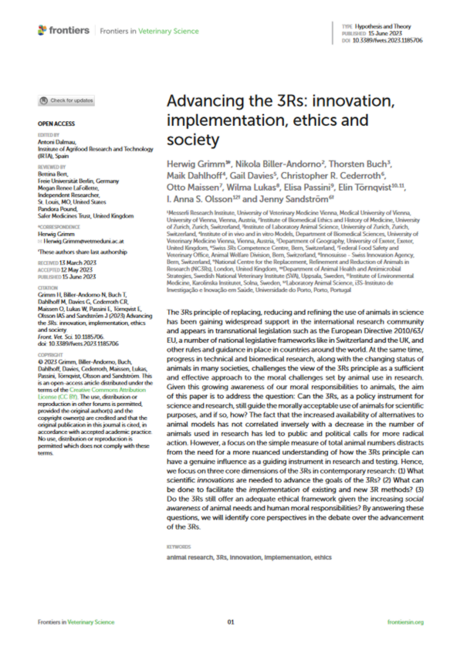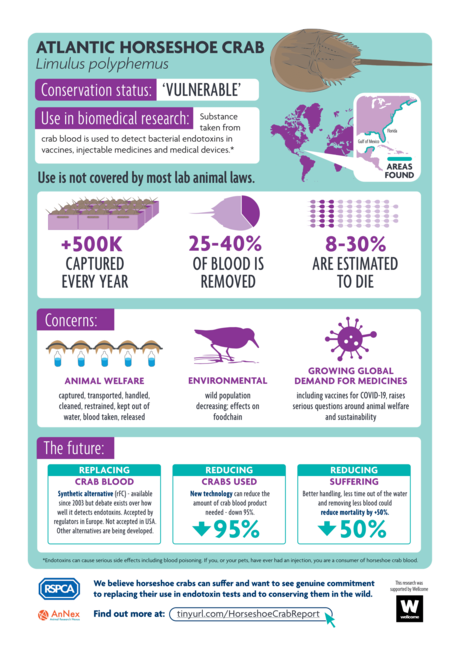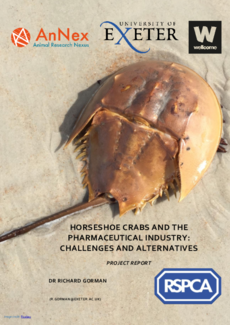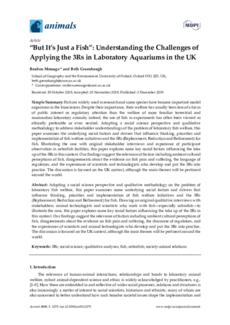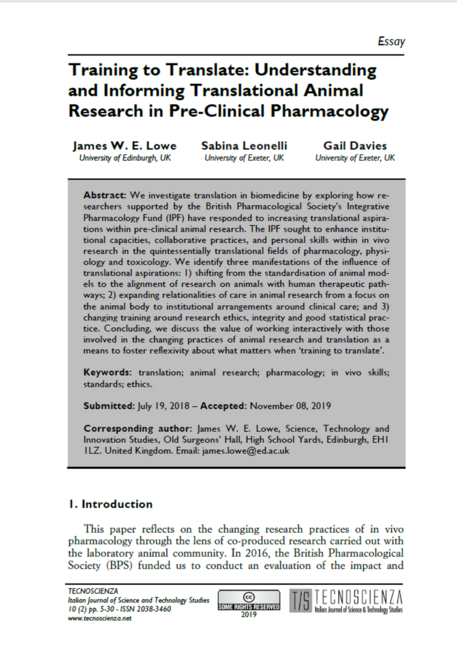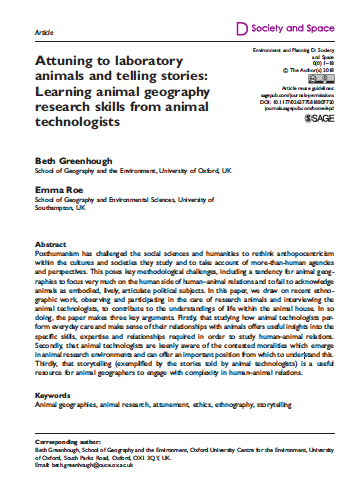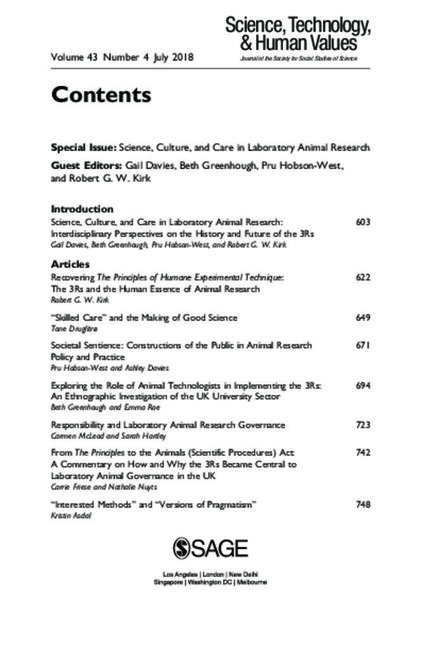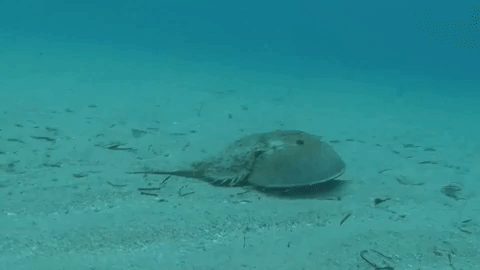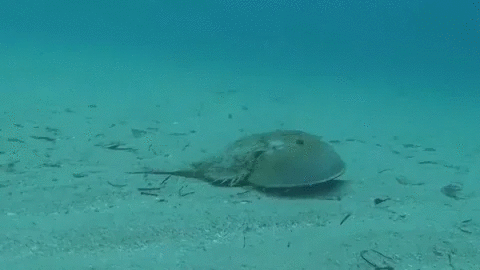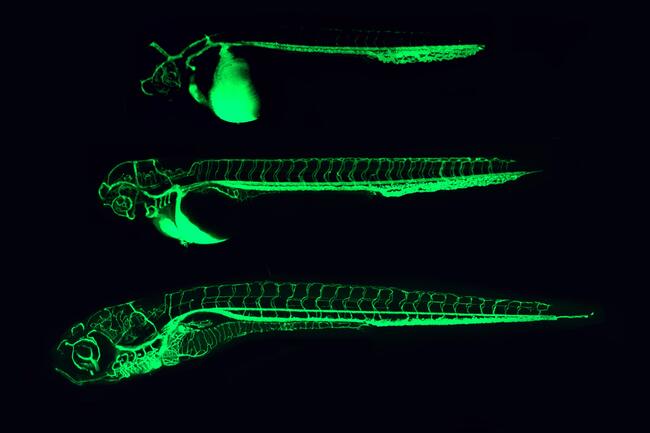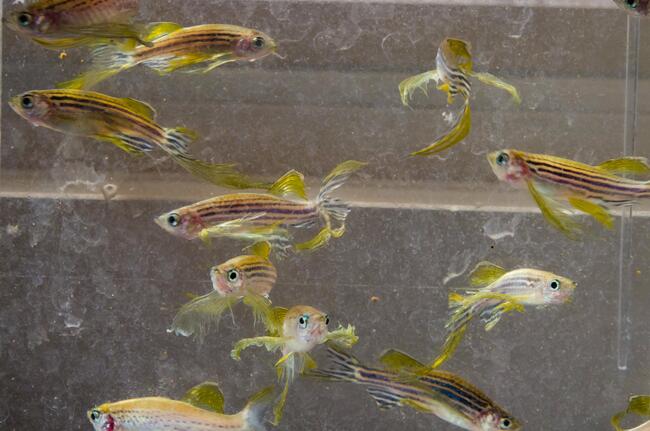3Rs
Publications
This article emerges out of the work of the The Swiss National Research Programme “Advancing 3R” (NRP 79). It features contributions from AnNex team member and NRP Steering Committee member Professor Gail Davies. The paper embodies and develops many of the aspirations of the AnNex programme in stating that: "Looking at the debate on advancing 3Rs from this angle, the humanities and social sciences are not the fifth wheel: they are as important as natural science and biomedicine in the project of advancing implementation of the 3Rs and developing the 3Rs themselves."
Endotoxin testing is a vital part of quality and safety control in pharmaceutical production. The primary method for this testing in North America and Europe is the limulus amebocyte lysate (LAL) test, a critical component of which is the blood of Atlantic horseshoe crabs (Limulus polyphemus). Procuring blood for LAL testing involves capturing and bleeding over 500,000 crabs from wild marine populations each year. Whilst efforts are made by manufacturers to return crabs to the sea following the collection of blood, there is a level of mortality and sub-lethal impact involved, prompting increasing discussions about welfare and ethics. The 3Rs – the ambition to where possible, replace, reduce, and refine the use of animals – are established and accepted worldwide as the best framework for governing animal-dependent science. However, the biomedical utilization of horseshoe crabs to produce the LAL test has rarely been viewed through a 3Rs framework. More recently, there has been a renewed attention on sustainable methods and alternatives to the LAL test. Drawing on in-depth qualitative interviews, this article examines stakeholder perspectives on opportunities for thinking with the 3Rs, considering current appetites to replace, refine, and reduce contemporary biomedical reliance on horseshoe crabs. The shape of conversations about the biomedical utilization of horseshoe crabs has shifted significantly in recent years, and the 3Rs are an important driver of change, offering the potential to advance the use of more sustainable methods, and realize the welfare considerations increasingly expected across science and society.
Rich Gorman’s secondment to the RSPCA explored the social relations shaping the use of horseshoe crab blood within pharmaceutical endotoxin testing. This involved 13 stakeholder interviews, and has resulted in a stakeholder report alongside a peer-reviewed journal publication. Rich has also presented the research at industry conferences and academic seminars. This is the report and infographic produced for his research.
This report explores what a social science perspective might add to understanding the debates surrounding the use of horseshoe crabs in endotoxin testing. It draws on qualitative research with stakeholders, alongside documentary and policy analysis to examine the various perspectives, positions, and sides of debates about horseshoe crabs. This report attempts to represent the wide diversity of stakeholder perspectives about the biomedical use of horseshoe crabs in a balanced manner.
This paper examines some underlying social factors and drivers that influence thinking, priorities and implementation of fish welfare initiatives and the 3Rs (Replacement, Reduction and Refinement) for fish. Drawing on original qualitative interviews with stakeholders, animal technologists and scientists who work with fish—especially zebrafish—to illustrate the case, it explores some key social factors influencing the take up of the 3Rs in this context.
In this paper, in Tecnoscienza, we investigate translation in biomedicine by exploring how researchers supported by the British Pharmacological Society’s Integrative Pharmacology Fund (IPF) have responded to increasing translational aspirations within pre-clinical animal research.
This paper draws on ethnographic work with laboratory animal technologists to offer insights into the skills required to study human–animal relations and the role played by storytelling in negotiating the contested moral economies of animal research.
This special issue of Science, Technology and Human Values was guest edited by members of the AnNex team. It explores the changing situation of the 3Rs through five papers that explore how the 3Rs principles emerged, chart the ways they are enacted in practice, and reflect on their future challenges.
Blog entry
Rich Gorman’s secondment to the RSPCA explored the social relations shaping the use of horseshoe crab blood within pharmaceutical endotoxin testing.
As part of a Wellcome Trust Secondment Fellowship with the RSPCA's Research Animals Department Dr R
Over 175,000 rats are used in research and testing in the UK every year, with millions more used worldwide. Many of these are housed in cages that do not allow them to stand upright as adults. For example, the current Code of Practice to the UK 1
As part of a Wellcome Trust Secondment Fellowship with the RSPCA's Research Animals Department Dr R
"How different does a fish really feel from one day to the next?" Zebrafish larvae become protected animals at the age of 5 days post fertilisation. At 4 days, they are not. Why is this?
Events
Reuben Message presented at the RSPCA organised 'Focus on Fish' online event on the 23rd of February 2021.
